10 Tips to Help You Organize Your Inbox Email Messages
Struggling with a cluttered inbox? Then you should master email organization strategies to achieve Inbox Zero, a state where your inbox remains empty and you can swiftly locate important messages and effortlessly discard unnecessary ones.
We have a short video tutorial that explains how to organize your inbox and manage unwanted emails effectively. Watch it below and keep reading.

To help you achieve this daunting but very realistic goal, we collected the 10 best ways to organize email messages and attain a clutter-free inbox. As a bonus, we also included information on Clean Email, an email organizer that groups messages into easy-to-review bundles.
1. Begin With a Deep Inbox Clean-Up
If you've been neglecting your inbox for a long time, then you should begin with a deep clean-up to achieve the following goals:
- Removal of unnecessary messages: The first step in organizing your inbox is to get rid of any messages that no longer serve a purpose. This includes old promotional emails, outdated notifications, and any other irrelevant correspondence that's clogging your inbox.
- Organization of important correspondence: Once the clutter is cleared, it's time to focus on organizing the emails you need to keep. Create folders or labels (see the next tip) to categorize important emails, such as work-related communications, personal messages, or financial documents. This will help you quickly find specific emails when you need them.
- Prevention of future clutter: Unfortunately, it's not enough to perform one deep clean and be done with it. You also need to take steps to prevent future clutter. For example, you should unsubscribe from newsletters or mailing lists you no longer find valuable (see tip number 3).
If you've never performed a deep clean-up before and are just learning how to manage email overload, then you can go after the lowest-hanging fruit first with the help of an inbox cleaner like Clean Email.
Clean Email's Cleaning Suggestions can give you a head start by identifying the most impactful categories based on messages that you cleaned or are frequently cleaned by other users. To use the feature, you need to:
- Visit Clean Email's website or use the Clean Email mobile app for Android or iOS.
- Click the Try for Free button in the top-right corner.
- Sign in with your mail account.
- Select the Suggestions tool in the left pane.
- Click the action button to apply the suggested action.
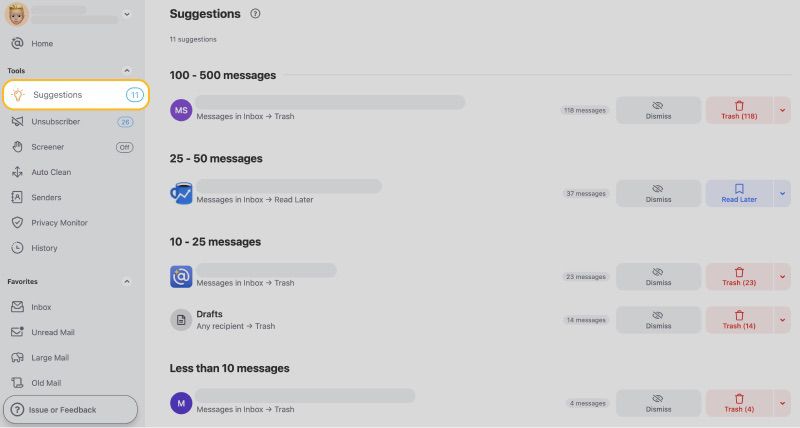

In a few simple clicks, your cluttered inbox can feel refreshed and ready for further organization by implementing the below-described strategies and taking advantage of other features Clean Email has to offer.
2. Organize Emails Using Labels and Folders
Learning how to organize emails using labels and folders is pivotal for managing a crowded inbox. While they might seem similar, labels and folders serve distinct purposes in email management:
- Folders: In most services, moving a message to a folder removes it from the main inbox.
- Labels: Labels in services like Gmail allow you to tag messages without moving them from the inbox.
If your goal is to organize Gmail, then labels are what you'll be using. But if you want to organize Outlook and many other email services, then folders will be your primary tool. Regardless of whether using folders or labels, you should always follow the same general steps:
- Identify categories: Start by identifying the main categories relevant to your emails. These could be based on the nature of the message (e.g., Work, Personal, Bills) or the action required (e.g., Reply, Read Later, Archive).
- Create folders or labels: Depending on your service provider, create folders or labels for each of these categories. In Gmail, go to Settings and then Labels to create new labels.
- Set up rules or filters: Automate the sorting process by setting up rules (in Outlook) or filters (in Gmail) to direct incoming messages to the appropriate folder or label. This can be based on criteria such as sender, subject keywords, or even content. In any case, Clean Email's Auto Clean feature can help you organize emails using smart and easy-to-create automation rules.

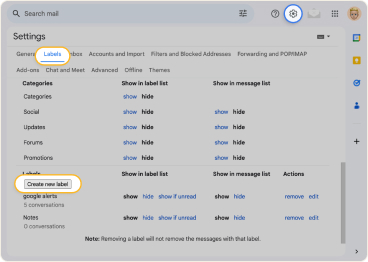
In Outlook and other services, you typically create folders by right-clicking on your Inbox or existing folder and selecting Create new subfolder.
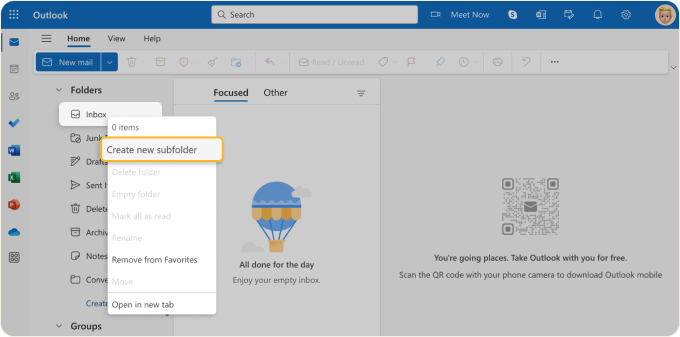
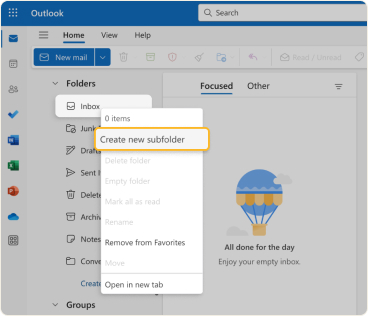
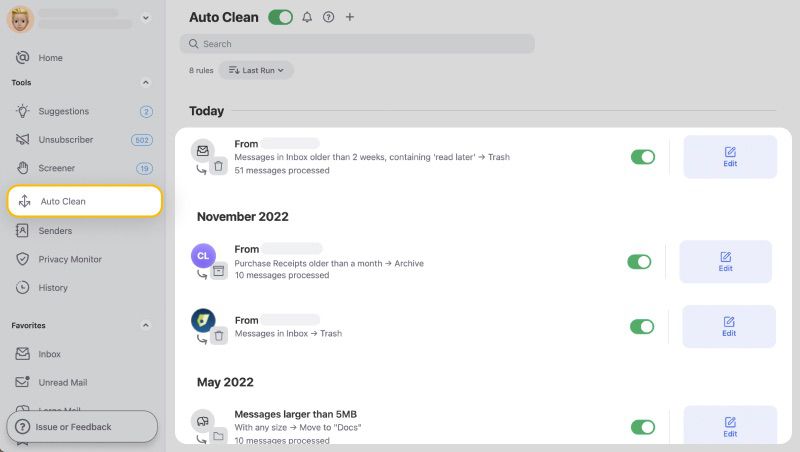
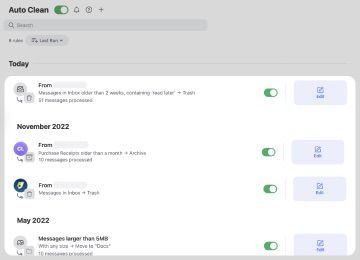
Of course, you can't expect to stay organized using the same labels and folders indefinitely. That's why it's important to adjust your folders, labels, and rules/filters as necessary, especially if your email habits or needs change.
Learn more about how to organize Outlook folders.
3. Unsubscribe from Unwanted Emails
Unwanted subscriptions are the main enemy of anyone who strives to achieve and maintain Inbox Zero. From newsletters to advertisements, they can quickly overwhelm your inbox and make it difficult to spot important messages.
Unsubscribing from unnecessary emails reduces the volume of incoming messages, allowing you to focus on what truly matters. This step is a critical component of effective email management strategies, whether you're looking to organize Yahoo Mail, organize iCloud emails, or do something else.
The traditional way to unsubscribe from mailing lists is to look for an unsubscribe button in the header of the email, or an unsubscribe link, typically found at the bottom of the message. Clicking on it should direct you to a page where you can confirm your decision to unsubscribe. While this method is effective, it can be time-consuming if you have a large number of subscriptions. What's more, it doesn't work if the sender hasn't included an unsubscribe link to begin with.
Fortunately, Clean Email offers a more efficient solution with its Unsubscriber feature:
- Log in to Clean Email with your email address.
- Select the Unsubscriber tool in the left pane.
- Review the list of active subscriptions.
- Click the Unsubscribe button next to each subscription you're no longer interested in.

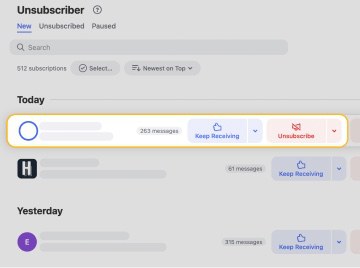
By utilizing this Clean Email's feature, you can quickly and effectively reduce the number of active unwanted subscriptions to zero.
4. Use Stars and Flags
Some mail providers, including Gmail and Outlook.com, offer the option to star or flag emails, a feature you should definitely consider using. It's a simple but effective way to visually distinguish emails you plan to revisit later. This can be especially helpful in prioritizing and managing your inbox efficiently.
Here’s how to star a message in Gmail on both desktop and mobile:
- Open your Gmail inbox.
- On desktop: Click the star icon to the left of the message.
- On mobile: Tap the email to open it, then tap the star icon at the top.
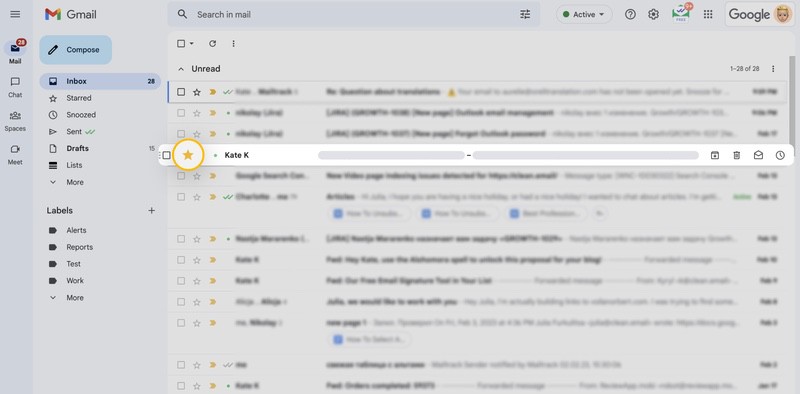
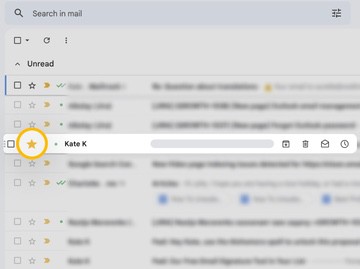

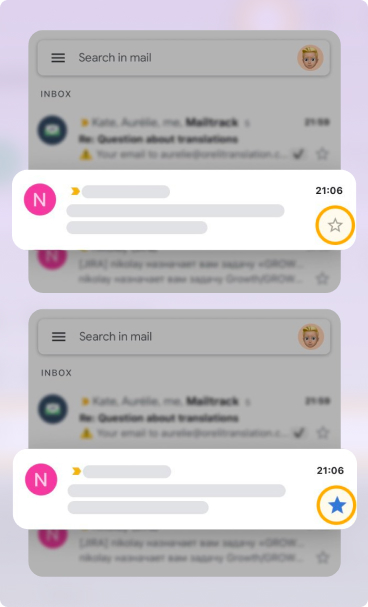
To flag a message in Outlook.com:
- Log in to your Outlook inbox.
- On desktop: Hover your mouse over the message you want to flag and click the flag icon.
- On mobile: Tap the message to open it, tap the three horizontal dots, then tap the Flag option.

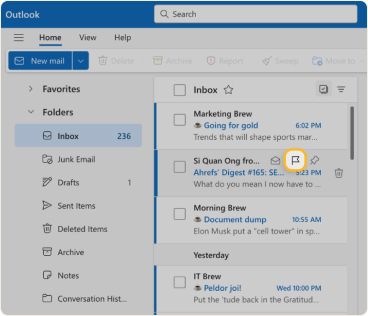

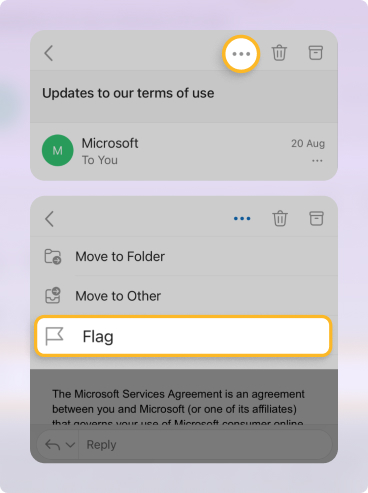
Some mail services even allow users to set up multiple stars and flags. This feature enables further differentiation of messages based on specified criteria, such as low, medium, or high urgency.
Just don't get carried away with flagging and starring emails. When most of your messages are flagged or a large number have multiple stars, it can be challenging to determine which messages are the most important. This abundance of flags and stars is only one of the email organization mistakes to avoid.
5. Archive Emails to Keep Your Inbox Clean
Message archiving is a simple yet effective way to organize emails and keep your inbox clean. It allows you to hide emails that are not immediately important but you're not ready to delete.
For instance, consider an email containing an assignment from your boss. Once you complete the task, instead of deleting the message and losing the ability to look back at it later, you can archive it. This action removes the email from your inbox, thus reducing clutter, but keeps it accessible for future reference.
To archive a message in Gmail:
- Desktop: Open your Gmail inbox, select the email or emails you want to archive, and click the Archive icon (represented by a box with a downward arrow) at the top panel.
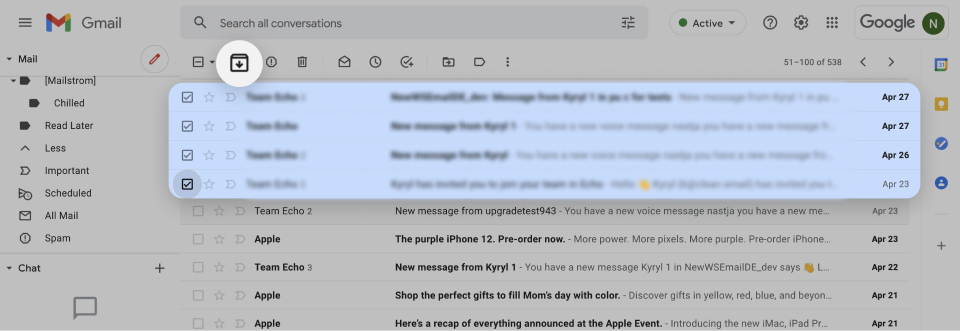
- Mobile: Open the Gmail app, tap the email to open it, then tap the Archive icon (box with a downward arrow) at the top of the screen.
To archive a message in Outlook:
- Desktop: Go to your Outlook inbox, select the email you want to archive, and click Archive from the top panel.

- Mobile: Open the Outlook app, select the email, and tap the More options (three dots) icon. From the dropdown menu, choose Archive.
After a while, you'll most likely notice that some types of emails consistently warrant archiving as soon as they arrive. For example, routine updates from a service you use, or informational newsletters that you like to read but don't need to keep in your primary inbox.
Clean Email's Auto Clean feature can be utilized to automate the archival of such emails:
- Launch the app and log in with your mail account.
- Select the Auto Clean tool from the left pane.
- Click the + icon to create a new rule.
- Give the new rule a name and configure all necessary parameters.
- Choose to apply the Archive action and save the rule.
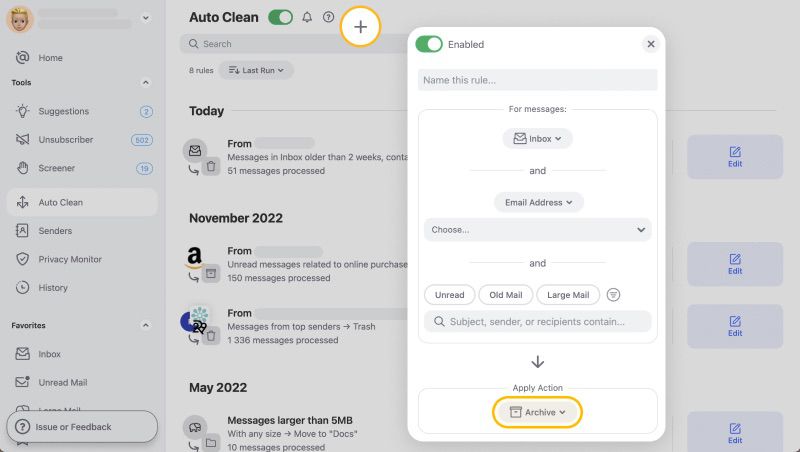
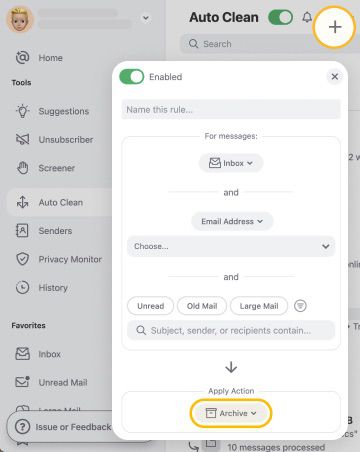
You can find and manage all active Auto Clean rules from the app's Control Center.
6. Create Email Accounts for Work and Personal Use
With email being a primary form of communication, having multiple accounts can significantly enhance your email organization strategy.
There are many excellent free services to choose from these days, so there's no reason to use a single mail account for all needs. Having multiple accounts (for example, one account for personal emails, another account for work messages, and a third account for online services) makes it easier to organize emails.
Your main options for creating additional email accounts can be divided into the following categories:
- General-purpose email services: Services like Gmail, Outlook, and Yahoo Mail fall into this category. They offer robust organization features, like labels and filters, which can help you keep your inbox tidy. For personal use, learning how to organize Gmail can be particularly beneficial due to its user-friendly interface and comprehensive email organization tools.
- Disposable email services: Temp Mail, DisposableMail, and other similar services are ideal for temporary use, such as signing up for one-time services or when you need an address quickly without the hassle of a full setup. They provide a layer of privacy and are useful for avoiding spam in your primary accounts. However, they should not be used for important communications, as they are typically short-lived and less secure.
- Privacy-focused email services: If privacy is a major concern, especially for sensitive work-related emails, consider using services like ProtonMail or Tutanota. Since they prioritize security and privacy by offering features like end-to-end encryption and minimal data collection, they can resist even fairly sophisticated attacks.
If you decide to create multiple accounts, it's crucial to use different, unique passwords for each one. This ensures that if one account is compromised, the others remain secure.
7. Deal With Important Emails First
Managing your inbox effectively means prioritizing the important messages so that urgent matters get the attention they need, and you stay on top of your commitments. Here’s a straightforward, five-step method to help you tackle your inbox efficiently:
- Quick scan: Start your day by quickly scanning through your inbox. Look out for emails from key contacts or those with urgent subject lines.
- Mark the essentials: Use the star or flag feature in your email client to mark emails that need immediate attention. This simple action helps in distinguishing the must-do’s from the can-waits.
- Clear the clutter: Once you’ve identified the important emails, quickly archive or delete the less important ones. This step instantly declutters your inbox, making it easier to focus on what’s essential.
- Address marked emails: Now, concentrate on the emails you’ve marked. Respond to, delegate, or take necessary actions on these as required. Tackling these emails first ensures that critical tasks are not overlooked.
- Deal with the rest: After handling the important emails, move on to the unmarked ones. These might include general updates, newsletters, or non-urgent queries.
Remember, tools like Clean Email can make this process even easier by automatically sorting your emails and removing unnecessary ones.
8. Snooze Emails for Later
Sometimes, messages arrive at the wrong time. When that happens, most people go with one of these two options:
- Option A: You can stop what you're doing and deal with the message.
- Option B: You can ignore the message and come back to it later.
If you choose Option A, you risk losing track of the original activity, which can cause your productivity to plummet. If you choose Option B, you risk making the sender wait for a response too long or forgetting about the message altogether.
Fortunately, there's also Option C: snoozing the message for later. Snoozing removes the snoozed message from your inbox temporarily and makes it reappear later when you have time for it. These days, snoozing is supported by most clients and services.
To effectively use the snooze feature in both Gmail and Outlook, follow these steps for desktop and mobile:
- Gmail (desktop and mobile): Open the message you wish to snooze. On desktop, right-click the message and choose Snooze from the options given, then select the date and time until which the email will be snoozed. On mobile, tap the three-dot menu and select Snooze. Then, choose when you want the email to reappear in your inbox.
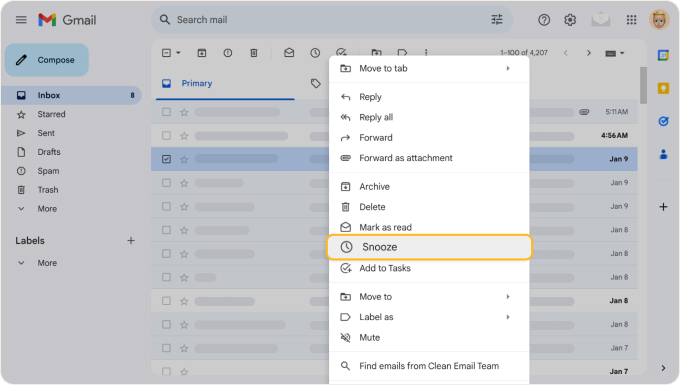

- Outlook (desktop and mobile): Navigate to the message you want to snooze. On desktop, right-click and select Snooze. On mobile, tap the email, then the three dots or More menu, and choose Snooze. Select the time for the email to return to your inbox.

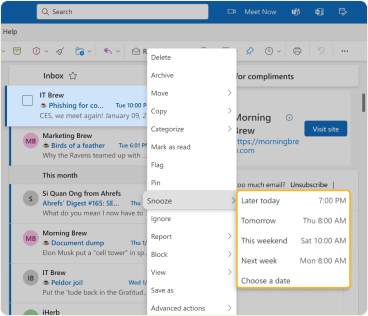
💡 Tip: For more detailed strategies on email organization, especially in Outlook, you can refer to how to organize email in Outlook.
9. Use Canned Responses
Why waste valuable time writing the same responses over and over when you can save them and enter them with one click? Canned responses are beneficial if you use email for work-related purposes. And you can use them to save time when asking about the status of your online purchases, for example.
Gmail users have it great because canned responses are supported natively—it just takes some work to enable them:
- Click the gear icon in Gmail and select See all settings. Then go to the Advanced tab, enable the Templates feature, and click Save Settings at the bottom.
- Start a new message by clicking Compose. Type the email message you want to save as a template. Click the three dots icon in the bottom right corner of the compose window, hover over Templates, then Save draft as template, and select Save as new template.
- Enter a name for your template in the prompt and click Save. This name will also auto-populate as your subject line.
- To use a saved response, start composing a new message. Click the three dots icon, hover over Templates, then select the desired template. It will auto-populate the body and subject line.
- Make any necessary personalizations to the message, add your recipient, and click Send.

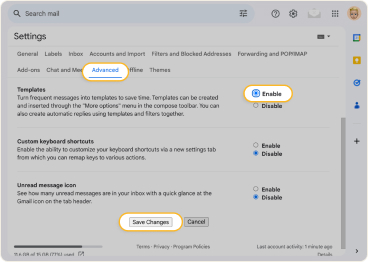
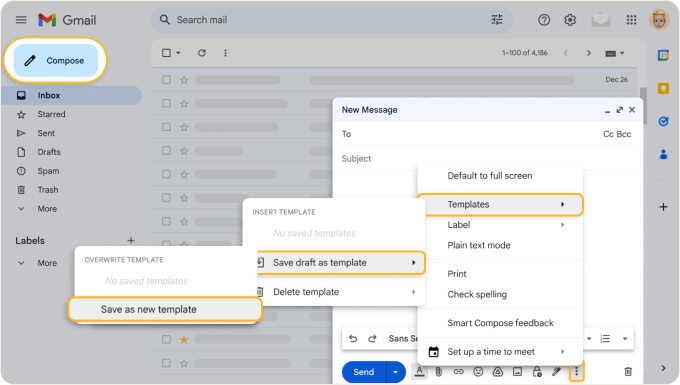
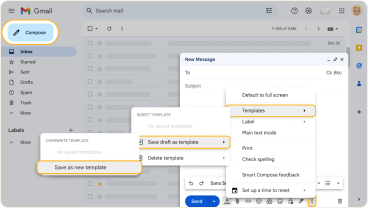
If your service provider doesn't support canned responses natively, you can still use this concept by saving responses in text files locally. Whenever you need to send a frequently used reply, simply open the text file, copy the response, and paste it into your email. This method, while not as streamlined as Gmail's canned responses, still offers a time-saving alternative to typing out repetitive messages.
10. Organize Your Inbox Regularly and Often
Consistent email organization of your inbox is key to maintaining control over your emails. We recommend you do the following:
- Set aside time: Dedicate blocks of time each day specifically for reading and responding to emails. These don't have to be long—10 to 15 minutes can be sufficient. The crucial part is consistency.
- Perform quick checks on your smartphone: Take advantage of your smartphone to organize your emails quickly when away from your desk. This can be especially useful during breaks or while commuting (if you’re not driving).
- Use automation tools: If manually organizing your inbox seems too time-consuming, email organizers like Clean Email can automate much of the process. By setting up Auto Clean rules, for example, you can automatically sort, archive, or delete emails based on specific criteria.
By regularly taking a few small steps in the right direction, you can complete your goal of learning how to organize emails in Gmail and other inboxes effectively without much struggle. What matters most is that you keep going.
How Clean Email Can Help Organize Emails
Clean Email is a bulk email organizer you can use to clean your inbox of emails you don't need and keep it organized. It sorts your messages into easy-to-review bundles so that you can remove, move, label, or achieve hundreds or thousands of messages with a single click.
Here are some common inbox organization problems that this app can help solve:
- Overwhelmed by new senders: The Screener feature is particularly useful if you frequently receive emails from new senders. When enabled, Screener holds messages from new senders outside your inbox. You can review these in Clean Email and choose to either block them permanently or allow them into your inbox.

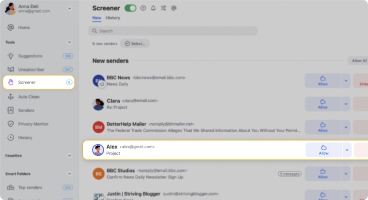
- Cluttered conversations: The Keep Newest function is designed for those who deal with numerous ongoing email threads. By selecting Keep Newest, the app ensures that only the most recent message in a conversation is retained, automatically clearing redundant past messages.
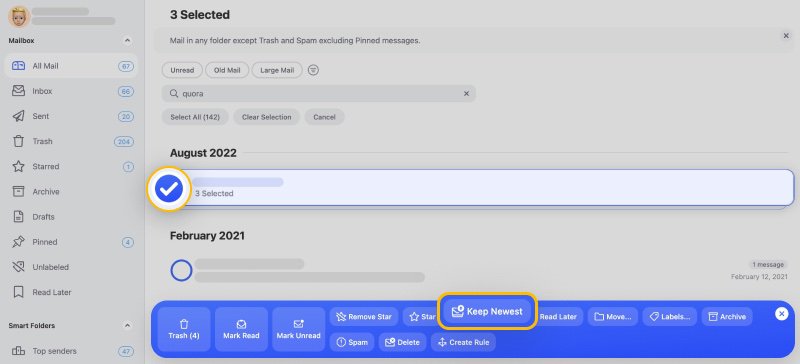
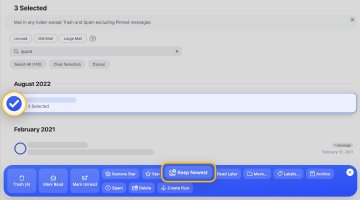
- Customized handling of frequent senders: With Sender Settings, Clean Email allows you to customize how emails from specific senders are managed. You can block senders, mark new messages as read, or automatically deliver messages to a specific folder. This level of customization is particularly useful for those who receive regular updates from specific sources and wish to automate how these messages are handled.
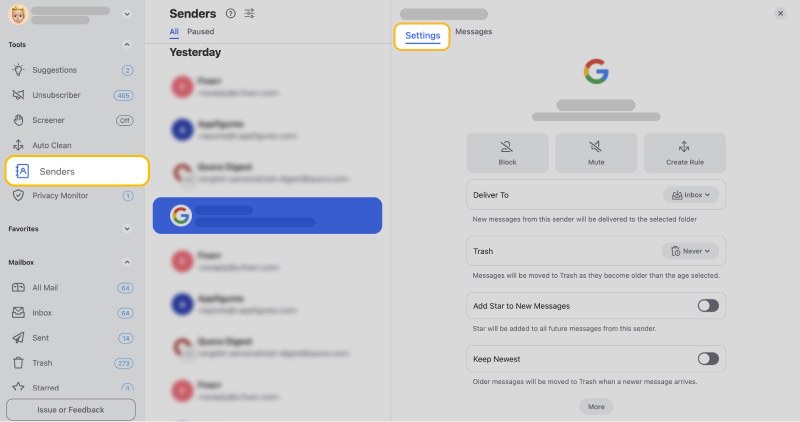
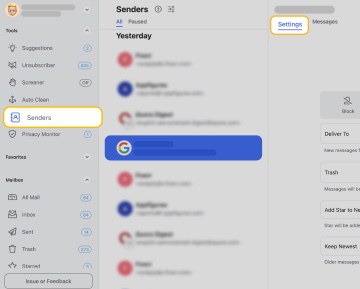
In addition to these invaluable inbox management capabilities, Clean Email distinguishes itself with a strong emphasis on privacy and security. Its Privacy Monitor feature alerts you to potential data breaches, safeguarding your email account. Alongside this, Clean Email's commitment to confidentiality means your personal data and emails are always treated with the utmost respect.
Clean Email's mobile-friendly design and dedicated apps for iOS and Android offer the flexibility and convenience needed in today's fast-paced world. This seamless integration across devices means that you can efficiently organize emails and stay on top of your inbox from any location.
Conclusion
Mastering inbox management is essential in today's digital world. The email organization strategies and tools outlined in this guide, including the advanced solutions provided by Clean Email, are designed to help you achieve an organized, clutter-free inbox. By incorporating these methods into your routine, you can transform the way you handle email communication, making it a more efficient and less overwhelming part of your daily life.
How to Organize Inbox Email Messages - FAQs
How to organize emails effectively?
Organizing emails effectively requires a multi-pronged approach that combines several inbox organization tips and tricks. Even then, any email organization strategy is effective only if exercised regularly and diligently, which is where many users fail.
What is the best advice for organizing email messages?
Many people interested in learning the best way to organize emails have never heard about inbox organizers like Clean Email, which can clean up a messy inbox in minutes. As such, the best advice for organizing email messages is to use a bulk mail organizer to save time and achieve Inbox Zero without much effort.
How do I organize my work email folders?
It’s a good idea to label all work-related emails accordingly and, if possible, keep them in separate folders. You can then organize these folders manually or use a bulk email organizer to remove emails quickly and efficiently from certain senders, archive old messages, and more.
How does the Clean Email app organize inbox email messages?
Clean Email is a capable inbox organizer with multiple features that you can use to clean your inbox with a few simple clicks. The app automatically groups similar messages, allowing you to manage them in bulk with a few simple clicks. It can also automatically Clean Emails matching specific rules to automate repetitive email management tasks, block unwanted senders, unsubscribe from newsletters, and more.
How to organize your emails using a mobile device?
With a mobile device, you can easily organize emails as they arrive, which is more efficient than allowing them to pile up in your inbox. We recommend you set up email notifications on your mobile device so that you never miss an important message. Just remember to turn them off when you need to focus or have a meeting coming up.
What is the best way to organize emails?
Bulk email cleaners, such as Clean Email, are the best way to organize emails. These cleaners organize emails automatically and make it simple to sort emails by sender, label groups of messages, and block unwanted senders. Plus, these tasks can be applied to existing and future messages.
How do I organize my personal email folders?
Organizing email into folders is similar to organizing your essential paperwork into manila folders. First, look at the types of messages you receive and note the different types of emails. Then, for each type of email, create a folder.
How do you manage thousands of emails?
The best way to manage thousands of emails is to use a bulk email organizer like Clean Email. Bulk email organizers work with your service provider and keep your inbox clutter-free by moving messages to folders, deleting unneeded and unwanted messages, and grouping messages that are similar.


